Check out our range of stock.
Didn't find what you like?
Send us a message
Found something out of stock?
Send us a message
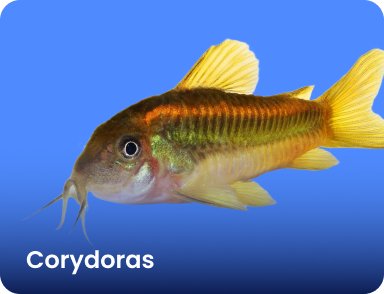
Discover the Charming World of Corydoras Catfish!
Short Description:
Welcome to the wonderful world of Corydoras! These peaceful, personable catfish are among the most beloved aquarium inhabitants for good reason. Perfect for community tanks, these social bottom-dwellers combine adorable behavior, practical cleaning habits, and stunning patterns in one irresistible package.
Why Choose Corydoras?
☮️ Peaceful Community Stars: Perfectly compatible with most fish, shrimp, and snails
👨👩👧👦 Social Behavior: Thrive in groups of 6+ - watching them shoal is pure delight!
🍃 Natural Clean-Up Crew: Expert at consuming leftover food and detritus
🎨 Stunning Variety: From classic patterns to rare exotic varieties
💪 Hardy & Adaptable: Great for beginners yet loved by experts
Shop By Experience Level
Beginner Favorites
Perfect for those new to Corydoras! These hardy species adapt well to various conditions.
Bronze Corydoras (Corydoras aeneus)
Pepper Corydoras (Corydoras paleatus)
Albino Corydoras
Emerald Corydoras (Corydoras splendens)
Intermediate Choices
For those ready to explore more specialized species!
Panda Corydoras (Corydoras panda)
Juli Corydoras (Corydoras julii)
Skunk Corydoras (Corydoras arcuatus)
Three Stripe Corydoras (Corydoras trilineatus)
Advanced & Rare Varieties
For the dedicated Corydoras enthusiast!
Sterbai Corydoras (Corydoras sterbai)
Adolfoi Corydoras (Corydoras adolfoi)
Pygmy Corydoras (Corydoras pygmaeus)
Venezuelan Orange Corydoras
Essential Corydoras Care Supplies
Set up your Corydoras for success with our complete selection:
Specialized Sinking Foods & Wafers
Smooth Sand Substrates
Driftwood & Hiding Places
Schooling Group Discounts
Water Conditioners & Medications
Corydoras Care Quick Guide
| Parameter | Ideal Range |
|---|---|
| Group Size | 6+ individuals |
| Tank Size | 20+ gallons |
| Temperature | 72-78°F (22-26°C) |
| pH Range | 6.0-7.8 |
| Substrate | Fine sand or smooth gravel |
| Diet | Sinking pellets, wafers, frozen foods |
Why They're Special
Corydoras aren't just fish - they're personalities! You'll love:
Their adorable "winking" behavior (actually gulping air!)
The way they constantly forage with their barbels
Their peaceful interactions with tank mates
The joy of watching a full group shoal together
Their reliability as indicator fish for water quality
Shop With Confidence
Our Promise:
🚚 Live Arrival Guarantee
👨👩👧👦 Healthy Social Groups
💧 Properly Acclimated
📞 Expert Support Available
📦 Carefully Packaged
Shipping Note: We ship Corydoras in groups for their comfort and safety. Acclimation guide included with every order.
Join Thousands of Happy Cory Keepers!
"My Panda Corys are the stars of my community tank! They arrived healthy and were actively foraging within hours." - Jennifer R.
"Finally found a source for quality Sterbai Corys. Their orange fins light up my planted tank!" - Mark T.
Ready to Start Your Corydoras Colony?
Browse our collection to find your perfect matches. Whether you're starting your first group or adding to an existing shoal, we have the quality and variety to meet your needs.
Shop All Corydoras →
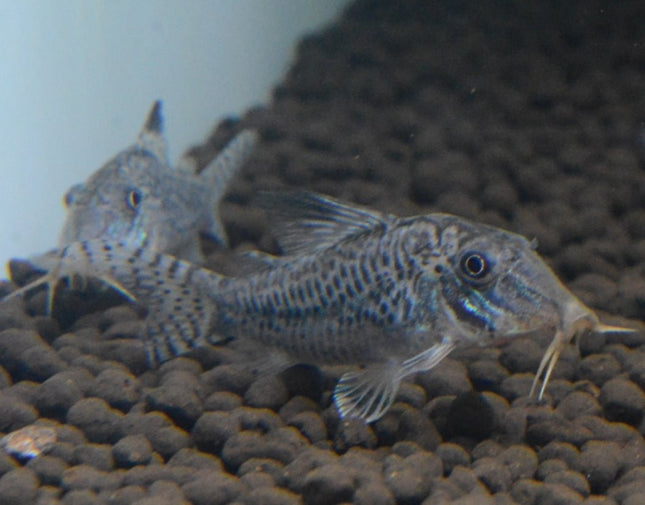
The blacktop corydoras (Corydoras acutus) is a tropical freshwater fish belonging to the subfamily Corydoradinae of the family Callichthyidae. It originates in inland waters in South America, and is found in the Amazon River basin in Ecuador and Northern Peru. It was described by Edward Drinker Cope in 1872. The fish will grow in length up to 1.7 inches (4.4 centimeters). It lives in a tropical climate in water with a 6.0–8.0 pH, a water hardness of 2–25 dGH, and a temperature range of 77–83 °F (25–28 °C). It feeds on worms, benthic crustaceans, insects, and plant matter. It lays eggs in dense vegetation and adults do not guard the eggs. The female holds 2–4 eggs between her pelvic fins, where the male fertilizes them for about 30 seconds. Only then does the female swim to a suitable spot, where she attaches the very sticky eggs. The pair repeats this process until about 100 eggs have been fertilized and attached. The blacktop corydoras is of commercial importance in the aquarium trade industry.
$50.00
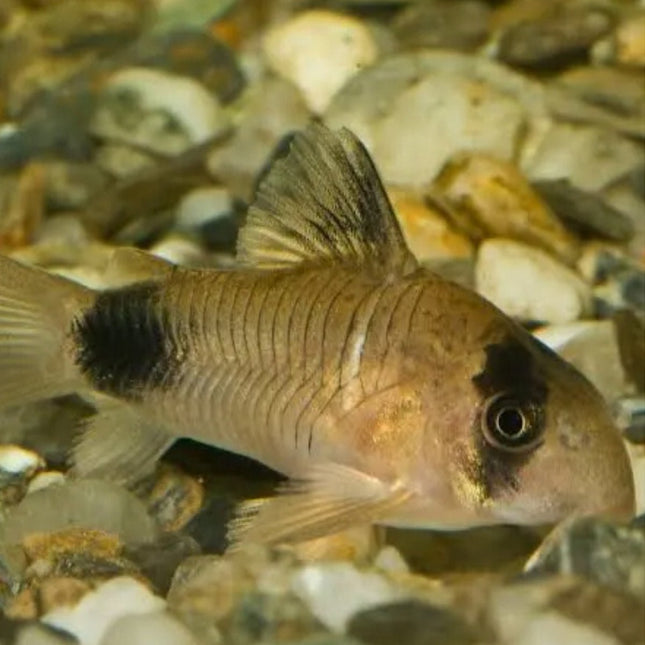
🌿 Calling all aquarium enthusiasts! Say hello to the delightful Corydoras Panda, now available at Nano Tanks Australia! 🐼✨ 🌈 The Corydoras Panda is a charming addition to any nano tank. With its striking black and white markings and playful personality, it's sure to become the star of your aquatic world. 🐼🌿 ✨ These bottom-dwelling catfish not only add visual appeal to your tank but also provide important functions. They are expert algae eaters and diligent scavengers, helping to keep your tank clean and well-balanced. 🌿🐠 📚 Here are some care instructions to ensure your Corydoras Panda thrives in its new home: 1️⃣ Tank Size: Provide a suitable tank with a minimum capacity of 10 gallons to allow for swimming space and proper filtration. 2️⃣ Water Parameters: Maintain a temperature range of 72-78°F (22-25°C) and a pH level between 6.5 and 7.5. Regular water testing and quality maintenance are essential. 3️⃣ Diet: Feed your Corydoras Panda a varied diet of high-quality sinking pellets, flakes, and occasional live or frozen foods. They also enjoy nibbling on blanched vegetables. 4️⃣ Tankmates: Corydoras Panda is peaceful and gets along well with other small, non-aggressive fish. Consider companions like peaceful tetras or small rasboras. 5️⃣ Hiding Places: Provide plenty of hiding spots like driftwood, caves, or dense vegetation to create a secure environment for your Panda Corydoras. 🏢 At Nano Tanks Australia, we take pride in offering top-quality fish for your nano tanks. Each Corydoras Panda is carefully selected for health, vibrant colors, and energetic behavior, ensuring you receive a fish of exceptional quality. 💪🌈 🔍 Explore the joy of owning a Corydoras Panda and witness their graceful movements in your nano tank. Visit our store today or browse our online collection to find the perfect addition to your aquatic family. 🛍️💻 💫 Don't miss this incredible opportunity to bring the delightful Corydoras Panda into your nano tank. Limited stock is available, so secure your adorable specimen today and create a captivating underwater world! 🌟🐠 #CorydorasPanda #NanoTankEnthusiasts #AquaticCharm #PremiumQualityFish #CareInstructions
$20.00
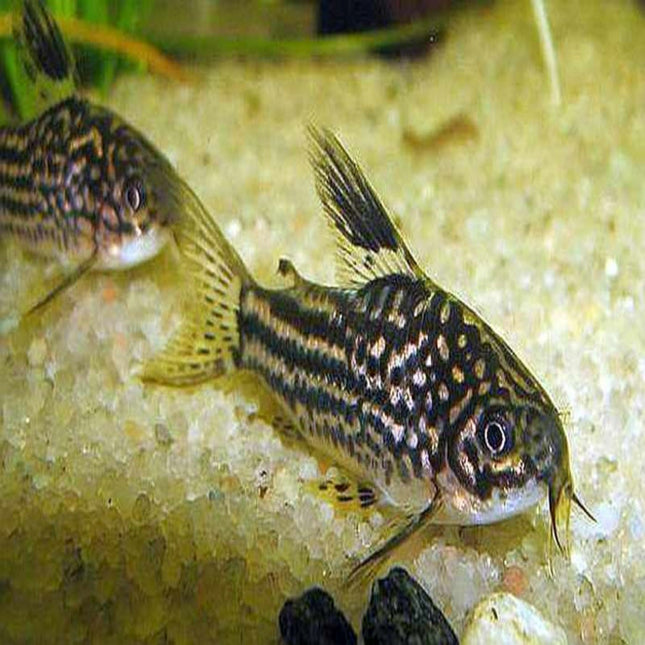
Elegant Corydoras, also known by its scientific name Corydoras elegans, is a small freshwater fish that is popular among aquarists. The Elegant Corydoras is a peaceful and social fish that is known for its distinctive and beautiful appearance. It has a silvery-white body with a black spot at the base of the tail and a vibrant orange stripe running along its back. The Elegant Corydoras is a schooling fish and should be kept in groups of at least six individuals to ensure their social needs are met. In terms of care, the Elegant Corydoras is a hardy fish that is relatively easy to care for. They are a great choice for beginner aquarists, as they are not overly sensitive to changes in water conditions. These fish prefer a well-planted aquarium with plenty of hiding places, as they are known to be shy and can be easily stressed if they do not feel secure. The Elegant Corydoras is a bottom-dwelling fish that is known for its love of scavenging, and they will happily eat any food that falls to the bottom of the aquarium. They should be fed a balanced diet that includes high-quality pellets, flakes, and frozen foods. Overall, the Elegant Corydoras is a great addition to any community aquarium, adding both beauty and personality to the tank. With their ease of care and peaceful nature, they are a popular choice for aquarists of all skill levels.
$39.00
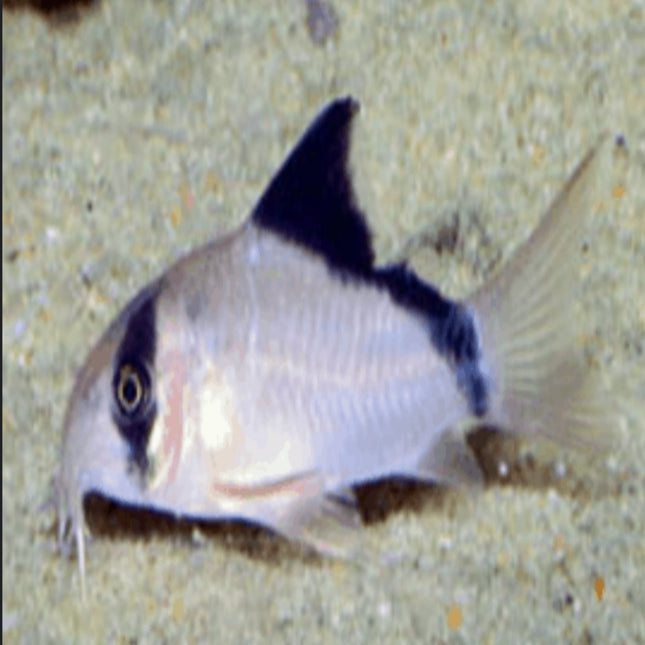
The Bandit Corydoras Metae, also known as the Meta River Corydoras or Meta Cory, is a small and captivating catfish species that is popular among aquarium enthusiasts. With its unique appearance and interesting behavior, the Bandit Corydoras Metae makes a delightful addition to any aquarium setup. These beautiful catfish are characterized by their striking black and white coloration. They have a sleek body with a black stripe that runs horizontally across their body, starting from the eyes and extending all the way to the tail. Above this black stripe, they have a shimmering silver-white body with a glossy finish, which gives them a striking appearance. Bandit Corydoras Metae are peaceful and social fish that thrive in a group setup. They are known to be relatively hardy and can adapt to a wide range of water conditions, making them suitable for both beginner and experienced aquarists. They are also known for their interesting behavior, often seen scavenging and foraging in the substrate for food, which adds to their charm. In addition to their attractive appearance and behavior, Bandit Corydoras Metae also serve a practical purpose in the aquarium. They are efficient cleaners, as they will sift through the substrate in search of food particles and help keep the tank clean by consuming leftover food and debris. This makes them an excellent addition to aquarium setups that require bottom-dwelling fish to help with substrate cleaning. Bandit Corydoras Metae are omnivorous, and their diet should consist of a variety of high-quality pellets, flakes, frozen or live foods such as bloodworms, brine shrimp, and daphnia. They may also consume some algae and vegetable matter. It is important to provide them with a balanced and varied diet to ensure their optimal health and well-being. When it comes to tank setup, Bandit Corydoras Metae prefer a well-decorated aquarium with plenty of hiding places such as caves, PVC pipes, or driftwood, where they can take shelter and feel secure. They also appreciate a sandy or fine-grained substrate that allows them to forage comfortably. A well-maintained aquarium with stable water parameters and a temperature range of 72-78°F (22-26°C) and a pH range of 6.0-7.5 is ideal for Bandit Corydoras Metae. In summary, Bandit Corydoras Metae are a captivating and peaceful catfish species that are popular among aquarium enthusiasts. With their striking black and white coloration, interesting behavior, and practical cleaning abilities, they make a delightful addition to any aquarium setup. Suitable for both beginner and experienced aquarists, Bandit Corydoras Metae are a wonderful choice for those looking to add a unique and charming fish species to their aquarium. So, if you're considering adding Bandit Corydoras Metae to your aquarium, be sure to provide them with a well-decorated tank, a varied and balanced diet, and optimal water conditions to ensure their health and happiness. Buy Bandit Corydoras Metae online from Nano Tanks Australia Aquarium Shop for expert advice and top-quality fish.
$30.00

Albino Bronze Corydoras are a popular and colorful species of freshwater fish that are often kept in home aquariums. These fish are a member of the catfish family, and are known for their peaceful temperament and social nature, making them a great choice for community tanks. Albino Bronze Corydoras are a relatively small fish, typically growing to be around 2.5 inches in length. They have a distinctive bronze coloration with a white underbelly and red eyes, which is why they are called "albino." The bronze coloration can vary in intensity from fish to fish, with some appearing more metallic than others. In addition to their striking appearance, Albino Bronze Corydoras are also known for their hardiness and adaptability. They are able to tolerate a wide range of water conditions, making them a great choice for beginner aquarists. They prefer soft, acidic water with a pH between 6.0 and 7.0, and a temperature between 72 and 78 degrees Fahrenheit. Albino Bronze Corydoras are also bottom-dwellers, meaning they spend most of their time foraging on the substrate for food. They are omnivores, and will eat a variety of foods including sinking pellets, flakes, and live or frozen foods such as bloodworms and brine shrimp. These fish are social creatures and prefer to be kept in groups of at least six or more. They are known for their playful behavior, often seen darting around the tank and exploring their surroundings. Providing plenty of hiding places and plants in the aquarium will allow them to feel secure and comfortable. Albino Bronze Corydoras are easy to breed in captivity, and can often be induced to spawn with a water temperature increase and frequent water changes. They are egg-layers, and will lay their eggs on plants or other surfaces in the aquarium. The eggs will hatch in 2-3 days, and the fry will be free-swimming within a few days after that. In conclusion, Albino Bronze Corydoras are a beautiful, hardy, and social species of freshwater fish that make a great addition to any home aquarium. Their playful behavior, adaptability, and ease of care make them a great choice for beginner and experienced aquarists alike. Whether you are looking to start a new community tank or add to an existing one, Albino Bronze Corydoras are definitely worth considering.
$10.00
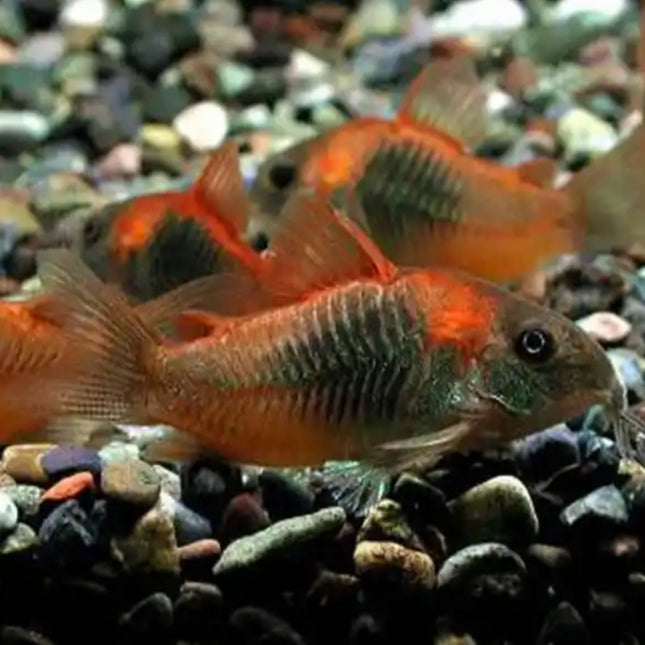
Corydoras Venezuela, also known as Venezuelan Corydoras or Corydoras adolfoi, is a small, peaceful catfish species that originates from the Orinoco River basin in Venezuela. These charming catfish are known for their striking appearance, with a unique pattern of black spots and bands on a light-colored body. They have a streamlined shape, with long barbels around their mouths that they use to search for food in the substrate. In addition to their eye-catching appearance, Corydoras Venezuela are known for their peaceful and social nature, making them great additions to community aquariums. They are generally peaceful with other fish species, and are best kept in groups of 5 or more to promote their natural shoaling behavior. Corydoras Venezuela are also hardy and easy to care for, making them suitable for beginner and experienced aquarists alike. These catfish are omnivorous, and their diet consists of a variety of foods including high-quality dry pellets, frozen or live foods such as bloodworms, brine shrimp, and daphnia, as well as vegetable-based foods like algae wafers or blanched vegetables. They are bottom-dwelling fish that will actively forage in the substrate for food, helping to keep your aquarium clean. At Nano Tanks Australia Aquarium Shop, we take pride in offering healthy and high-quality Corydoras Venezuela to our customers. Whether you're a seasoned hobbyist or just starting out, these captivating catfish are sure to add beauty, charm, and activity to your aquarium. Don't hesitate to contact us for expert advice or browse our selection online. Get your Corydoras Venezuela from Nano Tanks Australia Aquarium Shop today and elevate your aquarium to the next level! Happy fishkeeping!
$15.00
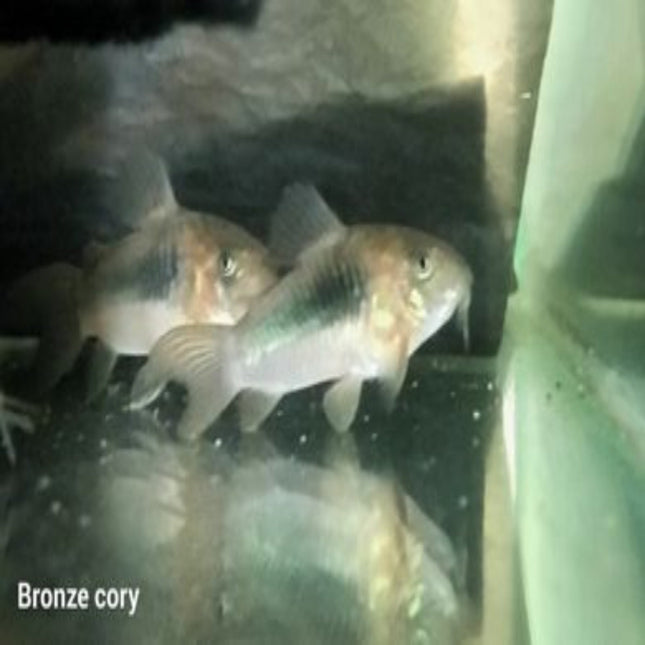
Bronze Corydoras (Corydoras aenus) is a small, peaceful freshwater fish from the family Callichthyidae. It is native to South America, from the Rio Orinoco basin in Venezuela to the Rio Tocantins in Brazil.This fish is a golden bronze color with a black band running along its body, and it has a prominent black stripe on its caudal fin, as well as some black spots on its dorsal fin. They are small in size, reaching up to 3 inches in length, and they have an average lifespan of 5-9 years. They prefer to live in a tank with soft, acidic water, and they should be kept with other fish of similar size and temperament. They are omnivorous, and their diet should include a variety of live and frozen foods. The Bronze Corydoras is an active scavenger and is a great addition to any freshwater community tank.
$10.00
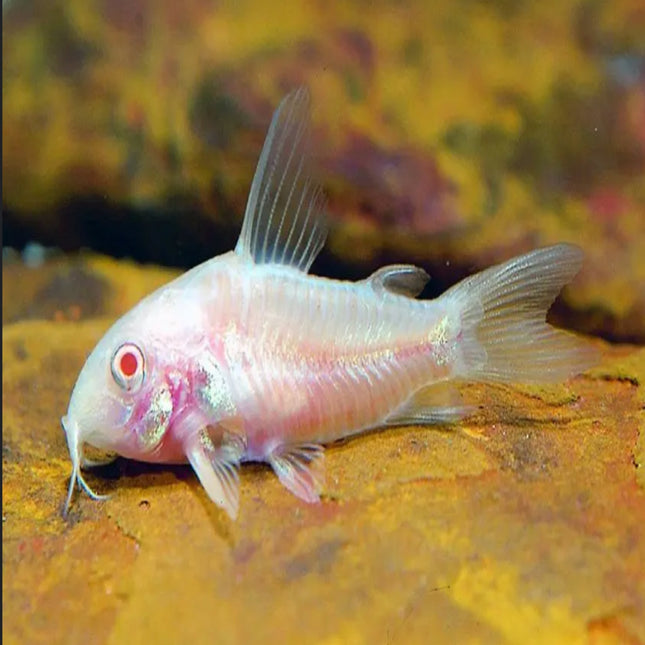
Corydoras Paleatus Albino is a popular freshwater fish that is commonly kept in aquariums. It belongs to the catfish family and is often referred to as the bronze corydoras or the peppered corydoras. This fish is known for its peaceful nature and is a great addition to any community tank. One of the standout features of the Corydoras Paleatus Albino is its unique appearance. It has a bronze-colored body with white stripes running along its sides. The Albino variant of this fish lacks the usual black spots on its body, making it even more eye-catching. It has a streamlined body shape that is designed for fast swimming, making it an active fish that adds a lively energy to any aquarium. The Corydoras Paleatus Albino is a small fish that typically grows up to 2-3 inches in length. They are generally hardy and easy to care for, making them ideal for beginner aquarists. These fish are best kept in groups of at least 6-8 individuals as they are social and thrive in the company of their own kind. They prefer a planted tank with plenty of hiding spots, as well as open swimming areas. In terms of water parameters, the Corydoras Paleatus Albino prefers a pH range of 6.0-8.0, with a temperature range of 72-78°F. They are adaptable to a variety of water conditions, but it is important to maintain stable water parameters to prevent stress and disease. Feeding the Corydoras Paleatus Albino is easy, as they are not picky eaters. They will readily accept a variety of foods, including flake, pellet, and frozen foods. It is important to offer a balanced diet that includes both protein and vegetables to ensure their optimal health. Overall, the Corydoras Paleatus Albino is a great addition to any aquarium. Their unique appearance, peaceful nature, and easy care make them a popular choice among aquarists. At Nano Tanks Australia Aquarium Shop, we take pride in offering high-quality fish that are individually photographed to ensure their premium quality. So why not consider adding the Albino Bronze Corydoras to your tank today?
$9.00
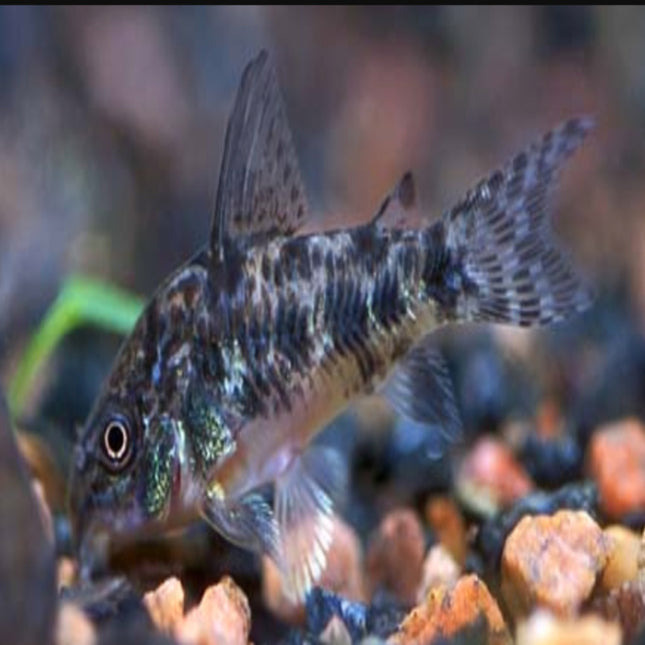
Genus Corydoras Species paleatus Common name Albino Cory Cat Origin South/Central America Tank Size min. 60 – 100 cm Temperature 22 – 25 °C pH Value 5.0 – 6.0 Fish Size 6-7 cm Food Omnivore Care Sociable, Group, Diurnal
$15.00
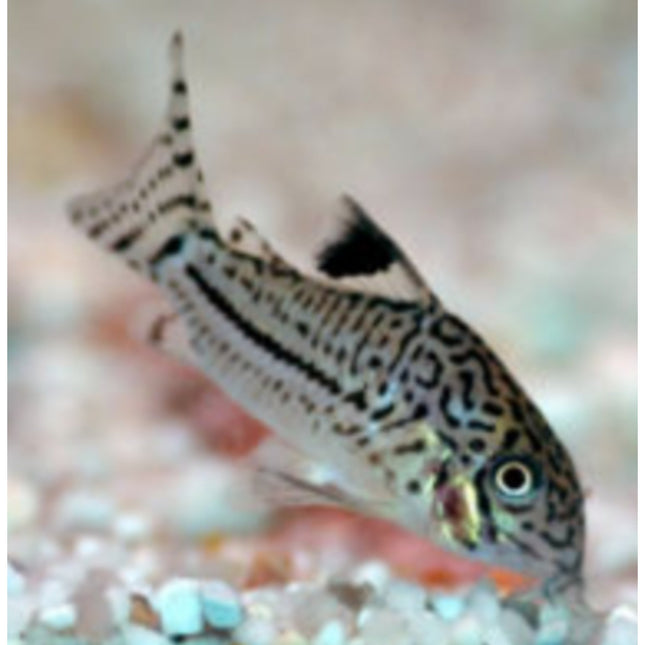
Three stripe - Juli's Cory Catfish (Corydoras trilineatus) OVERVIEW: Scientific Name Corydoras julii Family Callichthyidae Common Names Julii cory, julii cory fish, julii catfish Ease of keeping Easy Lifespan 7 years and more Tank size 30 gallons and more Temperament Peaceful Tank type Community of fishes Diet Omnivorous bottom feeder Temperature 72-78 °F (22-26 °C) pH 6.0-8.0 Water hardness 2–20 dGH Size up to 3 in (7.5 cm) The three-stripe corydoras is a freshwater fish that lives in the Amazon River basin and coastal rivers of South America. They are not aggressive fish, but they will defend their territory by chasing away other fishes with an impressive display of fins waving back and forth. When you are looking for a fish to keep in your aquarium, consider the three stripe corydoras. It is an interesting and peaceful species that can grow up to 2.5 inches (6.1 centimeters) long! The three-stripe corydoras live in water with pH levels between 6-8 as well as temperatures ranging from 72-79 degrees Fahrenheit, which makes it suitable for most homes' environments without needing specific care requirements or changes of temperature over time like some other animals might need. This type of animal feeds on worms, benthic crustaceans, insects, and plant matter among others so there will never be any food shortages when keeping one indoors either - perfect if you're trying not just to want something nice but also easy. COLOR: The colour of this fish is not what it seems. The underside is pale white, while the top side has a greenish tint to its skin that sparkles in the water. Three long stripes run along their sides and five vertical striped lines extend from head to tail on both fins for an amazing effect when swimming in open waters! BEHAVIOR: This shy fish is an interesting creature to observe, and planning a large group of three-band Corydoras will help them become more confident. They are said to be quite fearful because they find comfort in the presence of their fellow tankmates as well! COHABITATION: Corydoras trilineatus is a three-lined Corydoras species that has until recently been underappreciated in the aquarium world. They are very peaceful and never disturb other inhabitants, making them an ideal fish for anyone who wants to keep more than one type of animal together without any fighting or risk to their personal safety. BREEDING: When you want to breed your corydoras, make sure they are at a stage where their eggs have the best chance of hatching. Cory catfish can get pregnant any time between 3-8 years old but it's typically after age 5 when females produce bigger and better quality fry! Before this point in life, young female fish will still be able to give birth on occasion with some success or may lay infertile eggs which are more likely than fertile ones to become infected by a fungus that turns them into jellyfish looking deflated blobs. AQUARIUM: Corydoras prefer to inhabit tanks with rough surfaces and strong water currents for feeding. They can often be found near the bottom of a tank grazing on algae, detritus, or other filter-feeding organisms like shrimp. With small mouths but voracious appetites, these little fish are perfect for eating whatever gets stuck in your aquarium filters! FEEDING: Corydoras trilineatus is not difficult to feed, but it's always important to consider its preferred food. For perfect health, vary this basic diet with contributions in plants and invertebrates like tubifex or daphnia. And for the ultimate treat? Give them vase worms! If your Corydoras are struggling because other fish eat their meal faster than they can get at it during the day when lights are on- make sure you distribute meals only after dark so that all of your aquarium occupants have an equal chance of eating well without feeling threatened by one another.
$25.00 $14.00

Temperature: 72 to 79°F (22 to 26°C) pH: 6.4 to 7.4 Hardness: 2 to 15°H Each fish is 1.5cm Image from https://en.wikipedia.org/wiki/Pygmy_corydoras
$12.00
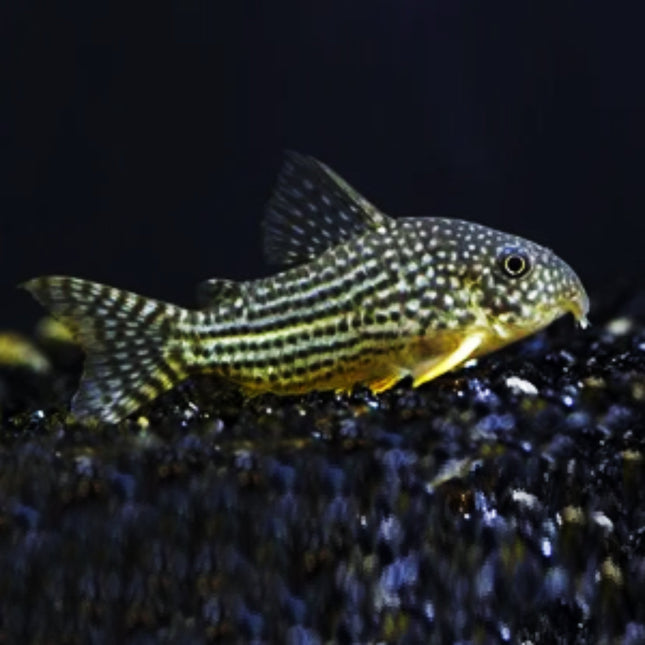
Corydoras sterbai is a small, peaceful fish that grows to a size of 3-3.5 cm (1.2-1.4 inches). It is native to South America, where it inhabits warm, slow-moving waters. This fish has a unique pattern of black, yellow, and white stripes and spots which makes it stand out in an aquarium. It is an active and peaceful fish that makes an excellent addition to a community tank, as it will get along well with other peaceful fish, such as tetras and small catfish. Corydoras sterbai is an omnivore, so it will eat a variety of prepared and live foods.
$15.00
![[LOCATED OFFSITE ARRIVED 23 - SEP - 2025] Red Laser Corydoras (Corydoras sp. CW014) 2 - 4cm - The Ultimate Collector's Cory - Nano Tanks Australia](http://nanotanksaustralia.com.au/cdn/shop/files/located-offsite-arrived-23-sep-2025-red-laser-corydoras-corydoras-sp-cw014-2-4cm-the-ultimate-collectors-cory-9846566.png?v=1758633594&width=645)
Experience the Brilliance of Red Laser Corydoras! Short Description:Behold the spectacular Red Laser Corydoras - one of the most vibrant and sought-after catfish in the aquarium world! Featuring an intense red-orange body accentuated by a bold black lateral stripe and metallic sheen, these stunning fish combine rare beauty with all the endearing personality Corydoras are known for. Key Features & Highlights 🔴 INTENSE RED-ORANGE COLOR: Vibrant, laser-red coloration that creates an stunning visual impact against dark substrates and green plants ⚫ BOLD CONTRAST STRIPE: Sharp, dark lateral stripe that perfectly accents the bright body color for maximum visual appeal ✨ METALLIC SHEEN: Captivating metallic glow that shimmers under aquarium lighting, making these fish truly sparkle 👨👩👧👦 SOCIAL SCHOOLING BEHAVIOR: Thrives in groups of 6+, displaying fascinating group dynamics and natural foraging behaviors 💎 COLLECTOR'S DREAM: A premium, highly desirable variety that represents the pinnacle of Corydoras breeding achievements Detailed Description Welcome to the elite world of Red Laser Corydoras! This exceptional variety represents years of selective breeding, resulting in a fish that seems to glow from within. The "laser" name is perfectly deserved - when a school of these crimson beauties moves across your aquarium, they create a breathtaking display of color and activity that's unmatched in the catfish world. What sets the Red Laser Corydoras apart is its remarkable combination of spectacular appearance and charming Corydoras personality. Despite their premium status, they display all the endearing behaviors that make these catfish so beloved - from their playful group dynamics to their constant substrate sifting. Watching a school of these vibrant fish work together is like observing living jewels in motion. These catfish are particularly stunning in planted aquariums where their intense red coloration creates dramatic contrast against green plants and dark substrates. Their peaceful nature and efficient cleaning habits make them both a visual centerpiece and a practical addition to any serious aquarist's collection. Perfect For: Planted display aquariums Serious Corydoras collectors Peaceful community tanks Aquarists seeking premium fish Breeding projects Specifications & Care Guide Parameter Requirement Scientific Name Corydoras sp. CW014 Common Names Red Laser Corydoras, Laser Cory Tank Size 20+ gallons for a school Temperature 72°F - 79°F (22°C - 26°C) pH Range 6.0-7.5 Water Hardness Soft to moderately hard (2-15 dGH) Adult Size 2-2.5 inches (5-6 cm) Diet Omnivorous - sinking pellets, wafers, frozen foods Lifespan 5-8 years with proper care Care & Feeding Tank Setup: Fine sand substrate essential for barbel protection Dark substrate recommended to enhance coloration Plenty of hiding spots and smooth decor Peaceful tank mates only Diet: High-quality sinking pellets and wafers Frozen and live foods (bloodworms, brine shrimp) Color-enhancing foods to maintain vibrancy Forages for leftover food and detritus Social Needs: Keep in groups of 6+ individuals Becomes more active and confident in schools Displays natural shoaling behaviors in proper groups Important Considerations ⚠️ GROUP REQUIREMENT: Must be kept in groups of 6+ for natural behavior and well-being 🚫 SENSITIVE BARBELS: Requires smooth sand substrate to prevent barbel damage and infection 🐠 PEACEFUL TANKMATES ONLY: Keep with other gentle, non-aggressive species 🌡 STABLE WATER CONDITIONS: Requires clean, well-maintained water parameters 💎 PREMIUM PRICING: Higher cost reflects rarity and selective breeding efforts 🔍 OBSERVATIONAL FISH: May be shy initially but become bold in established groups Live Arrival Guarantee Our Red Laser Corydoras are carefully acclimated and conditioned for shipping. Each order includes detailed care instructions and our live arrival guarantee ensures your premium fish arrive healthy and ready for their new home. Ready to add these living lasers to your aquarium? Bring home the spectacular Red Laser Corydoras today!
$150.00
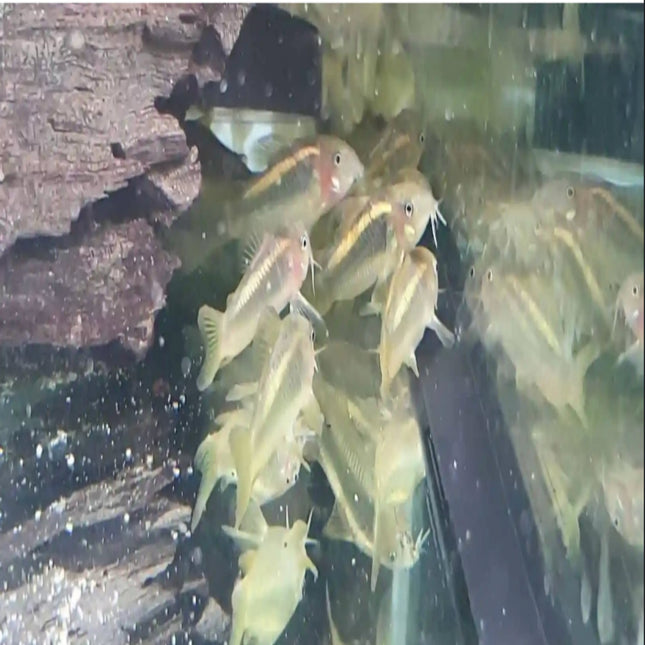
Synonyms N/ADistribution PeruSexual Dimorphism Females grow slightly larger and appear wider when viewed from above.Maximum Size 7.5cm (3”)Water Parameters Soft, acidic water is recommended. pH: 6.0-7.0, dH: up to 15 degrees.Temperature 20-27 deg C (70-80 deg F)Compatibility Soft water communityLighting No special requirements
$40.00